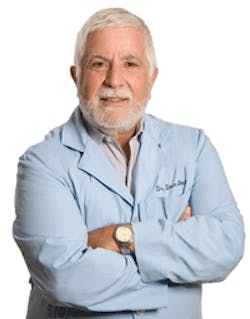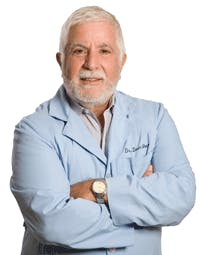Dr. Joe Blaes Interviews Dr. Diwakar Kinra
Q. What accounts for you having a thriving endo practice in Flint, Michigan, a city that certainly is not thriving in this economy?
A.My eight-year-old endodontic practice in Flint has been defying the odds for years. It is thriving because of a great team, an exceptional community of referring dentists, and a loyal patient base that has provided the best word-of-mouth advertising imaginable.
From my days as a practicing general dentist, I have remembered that building rapport is always my first goal in my patient interactions. World-class equipment that supports the most contemporary treatment techniques builds confidence in a practice. Yet the personal touch is as important in a specialty practice as it is in any general practice.
Q. I understand your patients are taken by your chairside relaxation/distraction slide show of your family. Can you tell us more about it and why you think it has been successful?
A. After my staff seats a patient in the treatment room, reviews his or her health history, and takes digital radiographs, they play a slideshow of my family that is displayed on the monitor at the end of the treatment chair.
I'm then able to build an almost instant rapport with my patients because they can relate to me as a husband and father rather than seeing me solely as a specialist whose treatment they hope to never need again.
Patients enjoy seeing pictures of my triplet 9-year-old daughters and 11-year-old son, from birth until now. The patients calm down as they inquire about life with triplets rather than thinking about their pain, the cost of treatment, or their follow-up appointments.
Interestingly, when a patient does return to our office, the slideshow is typically the first thing they ask to see upon being seated. They want to update themselves on my family, as I become reacquainted with theirs.
Q. When you test innovative products, what are the key criteria you apply to determine if you can recommend the invention or prototype?
A. I practice evidence-based endodontics. Solid research is essential for me before I incorporate new products into my practice. After assessing the available research, I clinically experiment with products on extracted teeth to become proficient on techniques before introducing them into my patient care regimen.
Furthermore, I will not teach, promote, or review any product until I perform the technique or use the innovation numerous times in the office. The number of product endorsers who advocate for products they've only recently been introduced to disappoints me.
I look for products whose inventors I'm most familiar with, whose manufacturers have an excellent record of quality control, and whose experts are more than marketing staffs for private label manufacturers.
Q. Do you see the endo specialty redefining itself in view of the significant movement toward implants?
A.Endodontists are at the crossroads of the decision to save a tooth or place an implant. I expect that we'll see more endodontists seeking training to better understand the range of implant choices when an endodontic re-treatment is the only other alternative.
Though I do not place implants at present, my referring dentists see me as a key decision maker in the treatment plan, always putting their patients' needs ahead of any other modality or economic consideration.
Q. You have strong family ties to IndiA.How has the Indian culture impacted your thinking about the balance between family, community, and professional obligations?
A. When my family immigrated to the United States in the '70s, I was 18 months old. Without extended family in a foreign land, the community became our family. Since that time, we return to India every three years or so to visit our entire extended family.
To this day, when I see my extended family, it doesn't matter if it's been three years, because we pick up where we left off and it seems like we never skipped a beat. Now, with the advent of social media and electronic communication, it has become even easier to keep in touch. But I never take for granted that I couldn't see my grandparents, uncle, and aunts on a regular basis. I don't let my kids take that for granted either, and they have a wonderful relationship with their extended family members who have come to the States, as well as those who have remained in India.
Q. Do you see yourself as teaching in India in the future?
A. In 2009, I was invited to India by the endodontic program director of M.A.Rangoonwala College of Dentistry to give a full-day hands-on endodontic course. We had over 150 participants and the course was very well received. What most impressed me at that time was the level of dentistry that was being performed by clinicians who were recent graduates. Truly high-level endodontic therapy was being delivered.
Ever since that first course, I have looked for opportunities to return and make an impact in Indian dental education. Happily, another opportunity has presented itself. This May, Stephen Buchanan and I will be presenting a two-day hands-on course in Mumbai. We will then be meeting with dental school deans and their leading students throughout the Mumbai and Delhi communities. It is my intention to build an important bridge to better continuing dental education during this extended trip. I am confident that it will lead to my spending more time in India making a difference.
Q. How do you see the dental training regimen in India as compared to U.S. dental schools?
A. India is very aware of the need to implement a strict training regimen that reflects standards set in the United States, the world's foremost center of dental education. The dental accreditation examiners in India are doing a fantastic job of placing strict guidelines on schools to make certain they are teaching their students to deliver appropriate standards of care.
There has been a trend in India of closing lower quality schools. We see about 8,000 dentists graduating each year in India, a much larger number than here in the United States. The quality of biological and clinical research coming out of many of these universities rivals current results found in the countries offering the highest level of dental care.
Q. There seems to be important growth in the number of Indian dentists who are now practicing in the U.S. What accounts for the ease of the transition from India to the U.S., given how radically different our economic circumstances appear to be?
A.There is a significant number of international dental students entering the workforce within the United States. In most cases, these dentists have to return to dental school in the U.S. To receive local accreditation, most go into advanced standing dental programs ranging from 18 months to three years, and then they have to take national examinations to become eligible to practice dentistry. This is the profession's way of standardizing the skills of all dentists practicing in the United States.
Essentially these international dentists end up going through dental school twice to practice in the States. This can be very costly, and as a result most are facing significant amounts of debt. This willingness to surmount these practical hurdles shows their level of commitment to practicing at the very highest levels of our profession.
Diwakar Kinra, DDS, MS, received his dental degree in 1999 from the University of Michigan and his master's degree in endodontics at the University of Detroit-Mercy in 2004. Afterwards, he began his solo private practice limited to endodontics in Flint, Michigan. He has lectured domestically and internationally on practice management and endodontics since 2007. For further information, contact Dr. Kinra at [email protected].
Past DE Issues

